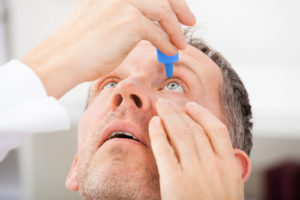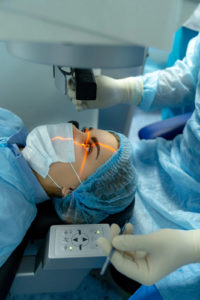Glaucoma is a degenerative eye disease that cannot be cured, but it is possible to slow down or even stop its progression with appropriate treatments. The goal is to stabilize the visual field and preserve the patient’s quality of life.
Why Treat Glaucoma?
Although a cure is not possible, treating glaucoma offers several essential benefits:
- Slowing or stopping its progression by lowering intraocular pressure to protect the optic nerve.
- Preserving vision and quality of life by preventing further deterioration.
- Ensuring lifelong follow-up to stabilize the disease and avoid new damage.
Your ophthalmologist will propose the treatment best suited to your situation, among the four classic options: eye drops, tablets, laser, and surgery.
Treatment with Eye Drops
Eye drops are often prescribed as a first-line treatment to reduce intraocular pressure by decreasing production or facilitating the drainage of aqueous humor. Their use must be regular and lifelong to be effective.
Eye drops with a single active ingredient:
- Prostaglandins are often used as a first-line treatment (1 drop in the evening). They can sometimes cause irritation or a change in the color of the iris.
- Beta-blockers, in cases where prostaglandins are contraindicated, are prescribed at a dosage of one drop in the morning and evening.
When one eye drop is not enough: Several eye drops may be prescribed if one alone is insufficient. It is advised to wait 15 minutes between each application. To facilitate adherence to treatment, fixed combinations (a single eye drop with two active ingredients) are often preferred.

Tablets
Tablets may be prescribed as a complement to eye drops to reduce intraocular pressure or improve blood circulation in the eye, particularly in cases of normal-tension glaucoma.
Possible side effects:
- Allergic reactions (redness, itching).
- Dehydration, fatigue.
- Metabolic disorders (hypokalemia, hyperglycemia).
- Kidney or liver problems (kidney stones, kidney failure).
- Transient myopia, hallucinations.
Laser Treatment
If medications are insufficient or cause side effects, laser treatment is an effective alternative to reduce intraocular pressure.
- Laser trabeculoplasty: Improves the drainage of aqueous humor through the trabecular meshwork.
- Iridectomy and iridoplasty: Used to treat closed-angle glaucoma.
- Transscleral cyclophotocoagulation: Reserved for advanced glaucoma, it reduces the production of aqueous humor.
Laser treatment is performed under local anesthesia, in the office, and does not require hospitalization.

Surgical Treatment
When glaucoma continues to progress despite other treatments, surgery is considered to create a passage to drain aqueous humor and reduce intraocular pressure.
Main procedures:
- Deep sclerectomy
- Trabeculectomy
The goal is to slow the loss of nerve fibers, but lost vision cannot be recovered. After the procedure, medical follow-up remains crucial to control intraocular pressure.
Precautions after surgery:
- Avoid intense physical effort for at least two weeks.
- Strictly follow recommendations for the use of post-operative eye drops.
- Consult promptly in case of pain, redness, or discharge.
Challenges of Traditional Treatments
Although traditional treatments are effective in slowing the progression of glaucoma, they present several limitations:
- Side effects: Medication and surgical treatments can cause undesirable reactions.
- Variable efficacy: Intraocular pressure may increase over time, requiring adjustments.
- Treatment adherence: Lifelong follow-up and the regular application of eye drops can be restrictive.
These challenges highlight the importance of regular follow-up and open communication with the ophthalmologist to adjust treatments.

Towards New Solutions: Innovation in Patient Care
To improve glaucoma management, innovative solutions are being developed. For example, Rheon Medical has developed the eyeWatch system, the first adjustable drainage device for surgical glaucoma treatment. This minimally invasive surgical device is recognized by specialists worldwide and allows for personalized adjustment of intraocular pressure.
Discover the testimony of Dr. Au, ophthalmologist at Manchester Royal Eye Hospital
By combining traditional treatments with innovations like the eyeWatch system, it is possible to improve the quality of life of glaucoma patients and provide them with more tailored and personalized care.
